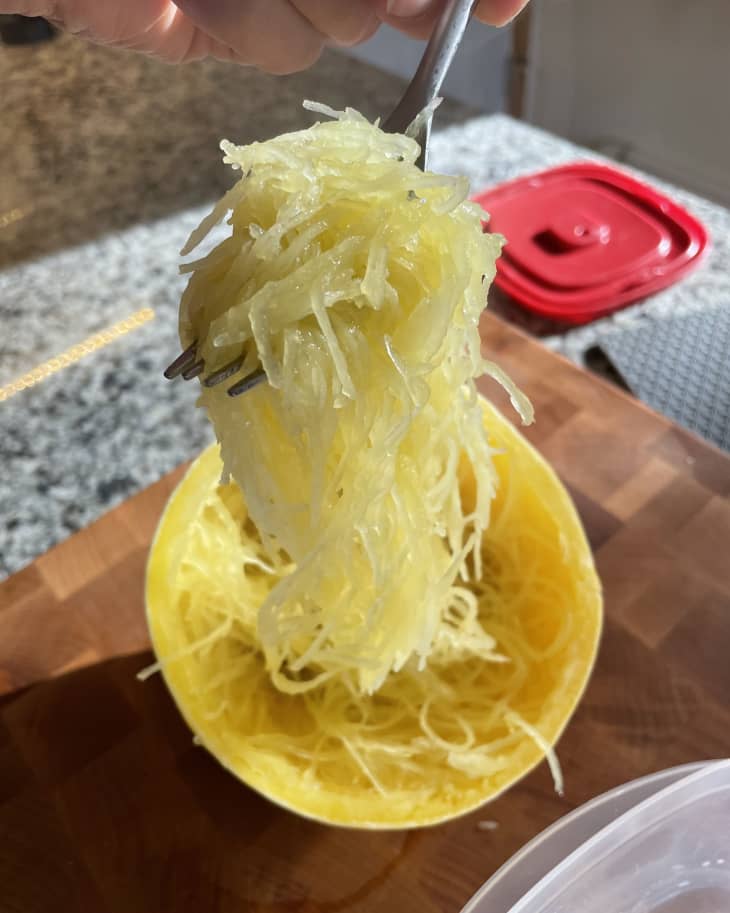I Tried the Viral Trick for Making Long Spaghetti Squash Noodles and It Really Works
No matter how you slice it (ha!), spaghetti squash is a great option for easy dinners and side dishes. This thick-skinned squash is unique, thanks to its interior of long, noodle-like strands. Unlike pumpkin or butternut squash, spaghetti squash can be prepared like pasta — tossed in a Mediterranean-inspired sauce, for example, or baked into a cheesy casserole.
Cutting a spaghetti squash can be tricky, thanks to that ultra-tough exterior. I recently researched the best way to cut a spaghetti squash and came up with two foolproof ideas: Either slicing it lengthwise, or into thick rings. I wrote that although the lengthwise technique was best for stuffed squash “boats,” the rings method was ideal for long, noodle-like strands; after all, that’s the way they grow inside the skin. But two videos on Instagram recently caught my attention: They both claimed to have the best way to prepare spaghetti squash, and neither one aligned exactly with my methods.
The best way to cut spaghetti squash is widthwise into two large pieces, according to this video by cooking instructor @plantainsandchallah, and this video, made by microwave cookware company Anyday (@cookanyday) and recipe developer @nomnompaleo. What makes this the best way? It’s a combination of Kitchn’s original two methods — you could say that it seemed like the best of both worlds. But did it really work? I put it to the test in my own kitchen.
How to Use This Trick to Cut Spaghetti Squash for Long Noodles
Both videos called for the same method of cutting the spaghetti squash: widthwise, into two large halves. I won’t mince words here: This technique is superior to either of my original methods if what you are after is long, tender noodles with none of the crisping around the edges you get from the rings technique. (Some would argue that those crispy bits are the tastiest, while others prefer the more pasta-like tender strands.) Where these two methods differed was in cooking techniques.
How to cut and cook spaghetti squash in the microwave for this technique
The first method by Anyday and Michelle Tam, the co-creator of Nom Nom Paleo, worked the best. To do it, you’ll cut a squash crosswise, and microwave it on full power for 10 minutes — the key here is to do it in a covered container with a splash of water. Once it’s cool enough to handle, use a fork to gently scrape the flesh away from the skin into long strands.
I liked this method most for two important reasons. First, it called for scooping out the seeds before cooking. That was much easier than the second method, for a reason I’ll explain a bit further down. The second reason was the most important: Cooking the squash with water in a covered container causes it to steam. That results in a super moist, tender texture that can’t be produced with any other method. Make sure the container is completely sealed, so the steam stays inside the container. (Anyday has a great dish for this, but any microwave-safe large bowl and tight-fitting lid would work.)
How to cut and cook spaghetti squash in the oven for this technique
The second method, shared by Sandy Leibowitz (@plantainsandchallah), calls for drizzling the squash with olive oil and salt, then roasting, cut-side-down in a 375˚ oven for 45 minutes. After that, you can scoop out the seeds and fluff with a fork.
I found that the seeds were trickier to remove after they’d been roasted, because they stuck to the rest of the inner flesh. As a result, I lost a bit of the edible portion when scraping out the seeds. That said, this is an easy fix: Just scoop out the seeds before roasting. The timing could vary for you based on the size of your squash and the actual temperature of your oven. I used a medium-sized squash, and needed 60 minutes to roast my squash to tenderness (15 minutes more than the original tip called for). I also found the olive oil drizzle and salt sprinkle unnecessary: It doesn’t permeate the squash past the initial layer, and you’ll have to re-season the squash anyway, when you use it in your recipe. Finally, the texture of the noodles was inferior to the microwaved version: You just can’t beat that steam bath!
However, Leibowitz did share my new favorite trick for cutting a hard spaghetti squash. After making an indentation in the skin with your knife, use the weight of the veg to your advantage by lifting it up, knife and all, and banging it lightly on the cutting board. The squash will practically split open all by itself! (In other words, no more dangerous fiddling around with a sharp chef’s knife.)
My Honest Assessment of This Spaghetti Squash Hack
Ultimately, I was a fan of both of these methods. If you want long spaghetti squash noodles that approximate real spaghetti, you should cut the squash in half crosswise, not lengthwise. But I won’t go so far as to say you should always cut spaghetti squash like that. If you want to make a stuffed spaghetti squash boat, the best way to cut it is still along the vertical axis. This creates long, shallow bowls that can be stuffed with lots of filling. But no matter which way you choose, be sure to put Leibowitz’s tip to good use and make the squash do all the work when slicing into it!
